What is an Energy Efficient Window, and why should you get one
Did you know that your windows are one of the biggest sources of energy loss in your home? In fact, most homes lose up to 30% of their heat through their windows. But there is a way to fix that – by installing energy-efficient windows! These windows can reduce your energy bill by up to 50%. Let's learn more about what an energy-efficient window is and why you should get one for your Carrollton home.
What is an Energy-Efficient Window?
True to their name, energy-efficient windows can reduce your energy bill, at times up to 50%. They are made of various materials, including glass, vinyl, and plastic and provide good insulation. This helps to keep your home cooler in the summer and warmer in the winter. In addition, they also have a variety of other benefits, such as reduced noise levels and improved security.
What are the benefits of an Energy-Efficient Window?
1.Savings on your heating and cooling bill
Energy-efficient windows help you save on your heating and cooling bills. Whether it's cold winters or hot summers, energy-efficient windows provide good insulation to keep your home comfortable and energy costs low. Window replacement and window repair can be expensive, but energy efficiency will pay for itself in the long run. If you are considering replacing or repairing windows in your home, energy efficiency should be a top priority.

2. Saving electricity
A properly installed energy-efficient window in Carrollton can reduce your reliance on electricity by up to 50%. If you're considering window replacement, be sure to choose certified energy-efficient windows. This certification ensures that your windows have been tested and rated for energy performance.
3. Improved air quality
Proper installation of an energy-efficient window will also improve the air quality in your home, helping you avoid asthma flare-ups and other health concerns related to polluted indoor air conditions (IACs).

Things to consider while purchasing an energy-efficient window
When looking to purchase energy-efficient windows for your Carrollton home, there are a few things you should consider. Energy-efficient windows with a high R-value help keep your home warm in the winter. Energy-efficient windows with a low U-factor help keep your home cool in the summer and keep energy costs down. Speak to a renovation expert in Carrollton to find which type would be most suitable for your home.
Choosing the right window type is another important consideration. There are three main types of energy-efficient windows: vinyl, wood, and aluminum. Vinyl windows are the most popular type of energy-efficient window and can be made to look like wood or aluminum windows. They are also the most affordable option. Wood windows are the most energy-efficient option, but they are also the most expensive. Aluminum windows are not as energy efficient as vinyl or wood windows, but they are more durable and can withstand severe weather conditions better than other types of windows.
The last factor to consider is the size of the window. Energy-efficient windows come in many different sizes, so you should choose one that fits your home's needs. You don't want to choose a window that is too small or too large because it will not be effective at saving energy.
If you're in the market for a new set of windows, be sure to consider energy-efficient options. Not only will they help keep your home warm in winter and cool in summer, but they could also reduce your energy bill by up to 50%.
Talk to us today about installing
energy-efficient windows in your Carrollton home – we can help you find the perfect window for your needs and budget.











